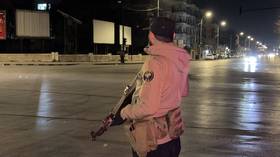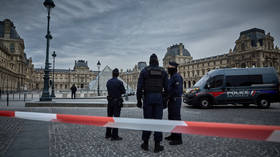
TOKYO— A Japan Airlines (JL) Boeing 787-9 operating flight JL22 from Beijing Capital (PEK) to Tokyo Haneda (HND) with 121 passengers and 11 crew encountered turbulence at cruising altitude, resulting in injury to a cabin crew member.
The aircraft was flying at FL410 about 110 nautical miles east of Seoul (ICN) when it experienced sudden lateral movement. A senior flight attendant sustained a fractured rib after being thrown against a seat during the turbulence. The aircraft continued safely to Tokyo Haneda (HND) and landed without further incident.
 Photo: File: Boeing 787-8 Dreamliner, Japan Airlines – JAL AN2227768.jpg – Wikimedia Commons
Photo: File: Boeing 787-8 Dreamliner, Japan Airlines – JAL AN2227768.jpg – Wikimedia CommonsJapan Airlines 787 Turbulence
Japan Transport Safety Board (JTSB) confirmed the incident involved a lateral upset, described as side-to-side rolling. The turbulence caused the flight attendant to fall against the side structure of seat 2D, leading to injury.
Although the crew member initially resumed duty, worsening pain after landing required medical evaluation, which revealed the rib fracture.
Because the event occurred in South Korean airspace, the Aviation and Railway Accident Investigation Board (ARAIB) of South Korea has jurisdiction to decide on a formal investigation. However, JTSB has also opened its own case and is coordinating with relevant authorities.
 Photo: Aero Icarus | Flickr
Photo: Aero Icarus | FlickrTimeline of Official Reports
On September 10, 2024, JTSB listed the occurrence in its investigation records, formally classifying it as an accident. Later, on August 28, 2025, JTSB released a progress update noting the investigation could not be concluded within one year.
The agency stated further analysis was required, including technical reviews and consultation with international stakeholders.
The interim report highlighted that weather conditions at the time were calm, with no clouds or storms nearby. The Boeing 787 briefly rolled left to right near waypoint PILIT before experiencing rough shaking. The upset subsided quickly, allowing the crew to continue the flight without operational disruption, Aviation Herald reported.
 Photo: Charles | Flickr
Photo: Charles | FlickrPassenger and Crew Impact
All 121 passengers completed the journey without injury, and the aircraft landed safely on schedule. The injured flight attendant was the only crew member affected. While turbulence injuries to passengers and crew remain relatively uncommon, they represent one of the leading causes of in-flight injuries globally.
Japan Airlines has not reported any additional safety issues related to this flight. The airline continues to support the injured crew member and is cooperating with investigators.
Turbulence incidents, particularly those occurring in clear air without visible weather cues, pose challenges for aviation safety. Airlines rely on forecasting tools, pilot reports, and weather radar, but clear-air turbulence can remain unpredictable.
Events like this highlight the importance of ongoing international collaboration between accident investigation bodies such as JTSB and ARAIB.
 Photo: Clément Alloing
Photo: Clément AlloingSimilar Incident
On November 15, 2024, American Airlines (AA) flight AA168 from Tokyo Haneda (HND) to New York John F. Kennedy (JFK) encountered severe turbulence that left two flight attendants injured during the long-haul service.
The Fort Worth-based carrier American Airlines (AA) continued the scheduled trans-Pacific flight, which later landed safely at New York JFK (JFK) after nearly 12 hours in the air, despite the turbulence incident being serious enough to prompt official reporting.
The Federal Aviation Administration (FAA) confirmed the turbulence event through its Aviation Safety Information Analysis and Sharing (ASIAS) system.
According to the FAA’s documentation, the Boeing 787-9 Dreamliner experienced moderate to severe turbulence, leading to injuries among the cabin crew while the flight was still en route over Japan.
While turbulence is a common occurrence in trans-Pacific operations, the FAA classified this incident as significant and requiring formal investigation. The regulator’s involvement underlines the seriousness of the event and the need for review of both operational procedures and weather-related conditions.
 Photo: Cado Photo
Photo: Cado PhotoFlight Tracking Data and Timeline
FlightRadar24 data shows American Airlines flight AAL168 departed Tokyo Haneda (HND) at 9:01 AM UTC on November 15. The service followed its usual trans-Pacific track, covering a journey time of around 12 hours before arriving at New York JFK (JFK) at 8:51 PM UTC.
Based on flight path analysis, the turbulence most likely occurred during the latter portion of the route near the United States coastline. However, the exact coordinates remain unclear from currently available tracking information.
The aircraft involved in the incident was a Boeing 787-9 Dreamliner, registered N833AA. At the time, the aircraft was seven years old and deployed on this high-demand international route connecting Tokyo and New York, a core market for American Airlines (AA).
Onboard the November 15 service were 279 passengers, eight flight attendants, and four pilots, totaling 291 people. Two of the flight attendants sustained injuries during the turbulence event. Despite the injuries, the aircraft continued its journey and completed the flight safely.
Japan Airlines Shanghai to Tokyo Flight Makes Emergency Landing at Kansai Airport
The post Japan Airlines Boeing 787 Turbulence Near Seoul Injures Cabin Crew: TSB appeared first on Aviation A2Z.


















